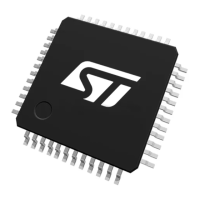RM0444 Rev 5 1293/1390
RM0444 Universal serial bus full-speed host/device interface (USB)
1307
Host channel-specific/device endpoint-specific registers
The number of these registers varies according to the number of endpoints or host channels
that the USB peripheral is designed to handle. The USB peripheral supports up to 8
bidirectional endpoints or host channels. Each USB Device must support a control
endpoint/channel whose address (EA bits) must be set to 0. The USB peripheral behaves in
an undefined way if multiple endpoints are enabled having the same endpoint/channel
number value. For each endpoint, an USB_CHEPnR register is available to store the
endpoint/channel specific information.
USB endpoint/channel n register (USB_CHEPnR)
Address offset: 0x00 + 0x4 * n, (n = 0 to 7)
Reset value: 0x0000 0000
They are also reset when an USB reset is received from the USB bus or forced through bit
USBRST in the CTLR register, except the VTRX and VTTX bits, which are kept unchanged
to avoid missing a correct packet notification immediately followed by an USB reset event.
Each endpoint/channel has its USB_CHEPnR register where n is the endpoint/channel
identifier.
Read-modify-write cycles on these registers should be avoided because between the read
and the write operations some bits could be set by the hardware and the next write would
modify them before the CPU has the time to detect the change. For this purpose, all bits
affected by this problem have an ‘invariant’ value that must be used whenever their
modification is not required. It is recommended to modify these registers with a load
instruction where all the bits, which can be modified only by the hardware, are written with
their ‘invariant’ value.
Bit 2 PDEN: Primary detection (PD) mode enable
– Device mode
This bit is set by the software to put the BCD into PD mode. Only one detection mode (DCD,
PD, SD or OFF) should be selected to work correctly.
Bit 1 DCDEN: Data contact detection (DCD) mode enable
– Device mode
This bit is set by the software to put the BCD into DCD mode. Only one detection mode
(DCD, PD, SD or OFF) should be selected to work correctly.
Bit 0 BCDEN: Battery charging detector (BCD) enable
– Device mode
This bit is set by the software to enable the BCD support within the USB Device. When
enabled, the USB PHY is fully controlled by BCD and cannot be used for normal
communication. Once the BCD discovery is finished, the BCD should be placed in OFF
mode by clearing this bit to 0 in order to allow the normal USB operation.
31 30 29 28 27 26 25 24 23 22 21 20 19 18 17 16
Res. Res. Res. Res. Res.
ERR_R
X
ERR_T
X
LS_EP NAK DEVADDR[6:0]
rc_w0rc_w0rwrc_w0rwrwrwrwrwrwrw
1514131211109876543210
VTRX
DTOG
RX
STATRX[1:0] SETUP UTYPE[1:0]
EP
KIND
VTTX
DTOG
TX
STATTX[1:0] EA[3:0]
rc_w0t t t r rwrwrwrc_w0t t t rwrwrwrw

